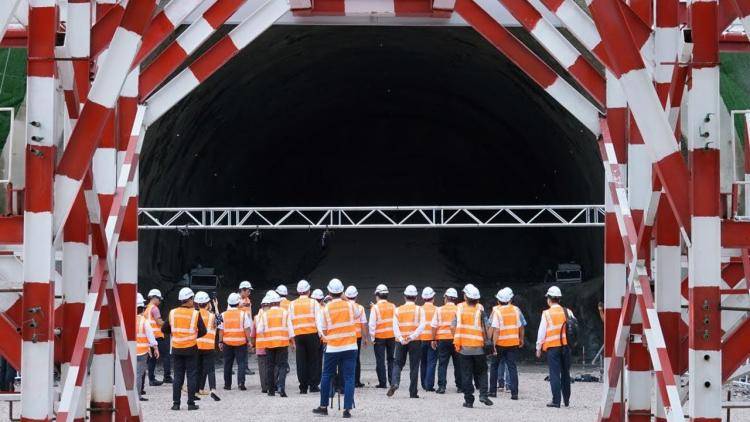British: Royal Institute of International Affairs,
Debunking the Myth of ‘Debt-trap Diplomacy’
Critics of the BRI accuse China of pursuing a policy of 'debt-trap diplomacy': luring poor, developing countries into agreeing unsustainable loans to pursue infrastructure projects so that, when they experience financial difficulty, Beijing can seize the asset, thereby extending its strategic or military reach. This paper demonstrates that the evidence for such views is limited.
 Officials visit the tunnel of the East Coast Rail Link project in Dungun, Malaysia on 25 July 2019. Photo credit: Rushdi Samsudin/Contributor/Getty
Officials visit the tunnel of the East Coast Rail Link project in Dungun, Malaysia on 25 July 2019. Photo credit: Rushdi Samsudin/Contributor/Getty
Lee Jones
Reader in International Politics, Queen Mary University of London
Shahar Hameiri
Associate Professor of International Politics, University of Queensland
Summary
 Event video: Speakers challenge the position that the Belt and Road Initiative (BRI) is a geopolitical strategy to ensnare countries in unsustainable debt and allow China undue influence.
Event video: Speakers challenge the position that the Belt and Road Initiative (BRI) is a geopolitical strategy to ensnare countries in unsustainable debt and allow China undue influence.
- The Belt and Road Initiative (BRI) is frequently portrayed as a geopolitical strategy that ensnares countries in unsustainable debt and allows China undue influence. However, the available evidence challenges this position: economic factors are the primary driver of current BRI projects; China’s development financing system is too fragmented and poorly coordinated to pursue detailed strategic objectives; and developing-country governments and their associated political and economic interests determine the nature of BRI projects on their territory.
- The BRI is being built piecemeal, through diverse bilateral interactions. Political-economy dynamics and governance problems on both sides have led to poorly conceived and managed projects. These have resulted in substantial negative economic, political, social and environmental consequences that are forcing China to adjust its BRI approach.
- In Sri Lanka and Malaysia, the two most widely cited ‘victims’ of China’s ‘debt-trap diplomacy’, the most controversial BRI projects were initiated by the recipient governments, which pursued their own domestic agendas. Their debt problems arose mainly from the misconduct of local elites and Western-dominated financial markets. China has faced negative reactions and pushback in both countries, though to a lesser extent than is commonly believed, given the high-level interests at stake in the recipient countries.
- To improve the quality of BRI projects, Chinese policymakers should develop a coherent, integrated decision-making system with sufficient risk assessment capacities and strict, clear and enforceable rules. This would involve tackling vested interests within China, particularly among commercially oriented agencies and in the state-owned enterprise (SOE) sector.
- Recipient governments must take greater responsibility for the evaluation of potential projects to ensure their viability and financial sustainability. They must also develop their ability to bargain with Chinese partners to make certain that local people benefit from the BRI. Since China continues to place great emphasis on host-country regulation, BRI partners must bolster their laws and regulatory environment.
- Policymakers in non-BRI states should: avoid treating the fragmented activities of the BRI as if they were being strategically directed from the top down; provide alternative development financing options to recipient states; engage recipients and China to improve BRI governance; and help improve the transparency of ‘megaprojects’.
- Civil society and political opposition groups in recipient countries should focus their efforts on demanding transparency and public participation around the design, feasibility, selection, pricing, tendering and management of megaprojects.
Global responses to China's Belt and Road Initiative
This International Affairs webinar will delve into how three states have approached the Belt and Road Initiative and what we can learn from this.
In this webinar, International Affairs authors will share their insights on how Japan is approaching China in the context of the Indo-Pacific, Chinese influence in Myanmar and Italy’s China policy.
International Affairs was started at Chatham House in 1922 to communicate research to members who could not attend in person. Over the last 100 years, it has transformed into a journal that publishes academically rigorous and policy-relevant research. It is published for Chatham House by Oxford University Press. Read the latest issue here.
China and Zambia: creating a sovereign debt crisis
https://academic.oup.com/ia/article-abstract/98/4/1347/6628400?redirectedFrom=fulltext
Abstract
Does Zambia's exceptionally high level of Chinese loan commitments provide insights into China's financial statecraft? Some have argued that Chinese lending to Zambia reflects China's purposeful use of loans to build leverage and perhaps acquire strategic assets. This article uses new data on Chinese loans, lenders and contractors and process-tracing to argue instead that Zambia is an extreme case of coordination problems in Chinese lending. Among all African countries with Chinese loans, Zambia has had the largest number of distinct Chinese lenders since 2000 (18) and the second largest number of different Chinese contractors winning Chinese loan-financed projects (29). This multiplication of stakeholders has created fierce and unregulated competition for infrastructure contracts in Zambia. In Beijing, ‘fragmented authoritarianism’ has meant an absence of top-down coordination of firms' and lenders' activities and thus few restraints. At the same time, Zambia's political leaders disregarded their own restraints on over-borrowing. Distinctive Chinese ideas about debt sustainability likely created additional disincentives for close Chinese monitoring. Finally, Zambia's history of frequent debt cancellations from China and other lenders likely exacerbated moral hazard risks.